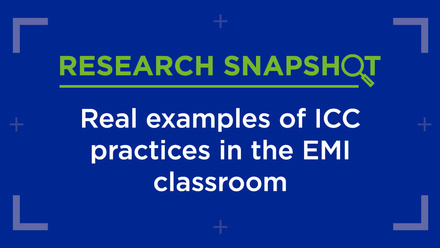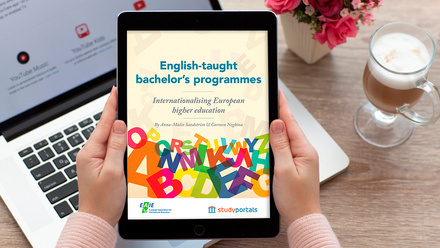Enhancing communication in English-medium instruction

Culturally diverse learning environments are dynamic and rich, but without the right support, they can also be filled with trials and frustration. With English-medium instruction (EMI) continuing to spread around the world, more higher education institutions in non-English-speaking countries are faced with the challenges of building effective intercultural classrooms.
Research on intercultural groups has revealed common barriers to successful cross-cultural interaction, and the most prevalent and potentially destructive relate to communication. To foster greater academic and personal satisfaction in the classroom, teachers and students must learn to navigate pitfalls such as linguistic limitations, imbalanced participation in group activities and insufficient intercultural awareness.
As a teacher and a student on an English-taught MA programme at a Japanese university, we have come together to share a few guiding principles that we believe may enhance communication in intercultural teaching and learning.
Make it inclusive: find ways to minimise linguistic gaps
Variance in linguistic ability is a standard challenge in EMI programmes. If students with limited English-language skills find it difficult to participate in collaborative work, this can diminish inclusiveness and effective group learning. For example, those who are unable to keep pace with the more proficient English speakers may withdraw into less active learning behaviours during group work. For the proficient students, this withdrawal can be frustrating: they may feel compelled to assume teacher-facilitator roles within their groups, and they might also feel that their less proficient classmates are relying on them to explain or interpret important content. Such situations can promote passivity among less proficient students and cause more proficient students to feel that class time is being wasted on academically unchallenging interaction with their peers.
In their 2016 volume Putting CLIL into Practice, Ball, Kelly and Clegg argue that one way to ease this problem is to exercise “primacy of task”, which involves making the task, rather than the text, central to the learning process. Putting the focus on the task – not the text, as in traditional teaching – allows students to focus on what is necessary to complete an activity without giving undue attention to details that are not essential to the task’s learning objective.
Intercultural competence is slow to develop, and far too important to the EMI classroom to be left to chance.
Using jigsaw activities (cooperative learning activities in which students are given or are required to find information that other students do not have and then to share that information) can further enhance group interaction. And assigning group roles and responsibilities well in advance of the group work itself can give students with linguistic limitations the opportunity to become ‘masters’ by preparing their unique contributions as homework; this allows more dynamic learning opportunities for all group members.
Combined, these approaches can make group work more inclusive by empowering students to make meaningful contributions to the class and by fostering cooperative learning that has a clear focus and is thus more manageable.
Make it flexible: offer various modes of participation
One difficulty in fostering active participation in a diverse community of learners is the potential lack of rapport between groups of international students. The general tendency for learners to self-segregate based on cultural background and language proficiency can hinder the development of interactional norms that support communication. It can therefore be beneficial to shift some emphasis from in-class discussions to out-of-class modes of communication. E-learning tools such as forum chats or message boards like those found at Moodle or Blackboard can be used by students on their own, potentially affording a voice to learners who hesitate to join discussions because of their unfamiliarity with turn-taking styles or their linguistic limitations.
If introduced early and utilised consistently, learner interaction outside the classroom can support the development of a more cohesive community within it.
These online tools allow students to engage in discussion and reflection while digesting complex material at their own pace – and the self-pacing and distance found in online communication can foster peer interactions across cultural boundaries. Discussions started outside the classroom may later be continued within it, giving confidence to struggling students who otherwise might have been unable or unwilling to participate. Additionally, online discussions provide a written record of learners’ responses to material, which can be valuable to teachers hoping to measure engagement and to identify problem areas. If introduced early and utilised consistently, learner interaction outside the classroom can support the development of a more cohesive community within it.
Make it a habit: promote intercultural awareness in every course
To help overcome challenges in intercultural communication, many EMI programmes have employed various forms of intercultural training. Some provide it for international students, some for local students and some for both, but there are still many programmes that do not provide it at all. For teachers, it is not safe to assume that the students in your class have received intercultural training somewhere else, though it may be easy to fall into this trap. Intercultural competence is slow to develop, and far too important to the EMI classroom to be left to chance.
Even if students have had some training, effective intercultural communication strategies can conflict with fundamental cultural belief systems. Because beliefs are resistant to change, the more exposure students have to intercultural communication, the better chance they have of developing lasting and transferable skills. Flanagan’s long-established critical incident technique or Holmes and O’Neill’s PEER model, for example, allow for the identification of misunderstandings brought on by cultural differences and can enable students to pre-emptively manage them as a classroom community.
Ideally, all teachers in an international programme should share the task of promoting intercultural competence among the student body, and as they work with their students they will deepen their own intercultural understanding. If teachers make a habit of beginning each term with an intercultural activity, particularly one that promotes empathy and flexibility, they can help to set the stage for a semester of better understanding, sharing and academic exchange.
The opportunity to develop intercultural competence is often a key marketing point in student recruitment for EMI programmes in non-English-speaking countries, but it is not always easy to deliver. In working towards a lifelong goal of intercultural competence, everyone involved must first learn how to communicate successfully. Putting the approaches mentioned here into practice can enrich experiences in EMI classrooms and help build the intercultural communication skills of the students within them.






